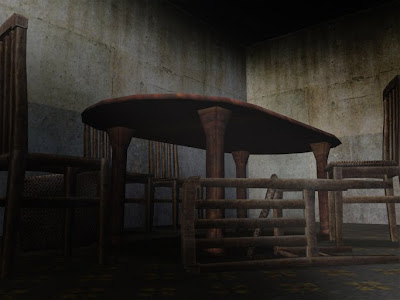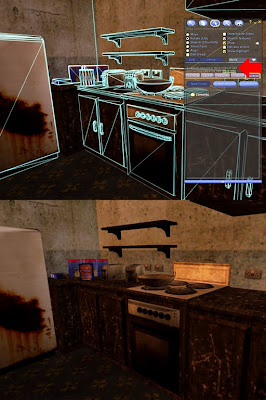The real problem isn't that mesh is some evil demon, but that change is frightening. While the photo above has horror elements to it, the fact that the trees and cross are the equivalent of one prim each is rather sweet. Take a minute to look at the textures on the tree in the foreground. Notice the many branches on the tree next to the cross. Intricate designs and beautifully baked textures are just two of the many benefits of mesh in Second Life.
It's no secret that I love mesh. It's also no secret that many people are unsure about mesh. Mesh isn't something we received a mandatory tutorial about. We weren't shuffled into virtual classrooms for a lecture on how it all works and why it makes SL look so pretty. It's really no surprise that, for many, seeking a mesh enabled viewer or enabling mesh functionality isn't seen as worth the effort.

Signs of a Struggle?
So, what is mesh? Simply put, mesh is a 3D model, created outside of Second Life, using programs like Maya and Blender (which have already seen a great deal of use for sculpted prims) and imported in-world for use. As a standard SL user, you won't need to worry too much about the creation details, but there are some things worth learning about this (fairly) new to SL technology.
There are many proponents and opponents of mesh in Second Life. I've seen enough amazing work using mesh to have joined the dark side. Don't let my alignment fool you, however; I know the limits of mesh, most of which have to deal with rigged mesh, something I'll discuss in a future post (or you can google it if you really don't want to wait). For now we'll keep it easy and talk about unrigged mesh (especially since I got some good photos of beautiful unrigged mesh while fighting with insomnia last night).
Unrigged mesh is any mesh creation that doesn't need to be able to bend or move with the avatar as it moves around (there's a definition of rigged mesh in there, too, if you look for it).

Unrigged mesh includes furniture, houses, boots that don't bend when the avatar bends and a variety of other Second Life items. Mesh items can be easily identified by right clicking on an object and choosing edit. By looking at the highlights that form around an object, you can easily tell if it's a sculpt or mesh object. The kitchen above uses a triangle polygon method (something that you don't need to worry about unless you want to create mesh designs for SL).
Rather than a prim count, mesh uses a land impact or prim equivalency count to determine how many sim resources a mesh object uses (see where the red arrow is pointing above). The land impact (prim equivalency) of 140 shown in the photo above is a bit high for just a kitchen. However, the photo doesn't show that that land impact number includes the entire building and much of the furnishings, including the table and several of the chairs shown earlier. Clean mesh construction keeps the designs from hitting extremely high land impact costs while bringing a higher level of intricacy and texturing than sculpts and prims offer.
Still not sure? Check out this storage rack on Marketplace. As more and more furniture creators learn mesh, we're going to be able to fully decorate our homes with beautiful objects that fit our personal styles without overwhelming our sim resources. Rather than hiding under the bed as mesh peeks in your bedroom door, why not come on out and embrace the mesh? You may find that the unpredictable, evil demon you've imagined is actually kind, logical and beautiful.
________________________________________
The photos for this post were taken at the Siden roleplay (RP) sim, a deliciously dark horror roleplay with flexibility to allow for text RP, combat RP, and survival RP (using a HUD supplied by the sim).

Good blog post, was nice to see someone else putting the word out about mesh and easing the pain of transforming. AS a builder, I fret stepping up my game as a mesh builder, but as with any new project comes stumbling blocks I am sure to hit. My new builds, off grid builds, will NOT be show to the public unless they are of decent quality. Thanks again for the easement.
ReplyDeleteThank you Markus. After seeing Siden's asylum, I'm tempted to learn mesh myself. The quality of the asylum build was rather stunning. I don't think that mesh buildings and furniture will completely replace prim furniture, but it adds another dimension to SL that is worth upgrading a viewer to see. Good luck with learning the mesh, though. I imagine you'll do amazing things with it once you get it down.
DeleteI am not sure if I remember correct but I don't think Linden Labs made it that pretty. I read somewhere a while ago that eventhough a mesh object looks like one well-crafted single prim, when rezzed on land it's equivalent to more than 1 prim as for the sim resources. I could be wrong though
ReplyDeleteHi Lolita! The chairs in the above pictures have a land impact of one. While I'm hardly an expert on mesh, I've been able to do quite a bit of research on it. Initially, it seems, mesh was registering very high land impact costs. Over time the creators improved mesh efficiency, creating beautiful works that are easy on the servers.
DeleteThe Second Life wiki states: However, in the hands of talented content creators, mesh provides the opportunity for the creation of highly engaging, detailed, and efficient objects in Second Life. The method used to calculate the effective prim count of a model that contains mesh differs from existing prims and sculpties by measuring the relative impact an object will have on the overall performance of a region. By contrast, prim and sculptie items only show a count of objects, with no consideration for their impact on rendering or server resources. This means that content creators who use mesh effectively can design objects and experiences that not only look amazing, but are optimized for better overall performance and a smoother user experience.*
Talented creators can develop efficient designs that are both highly detailed, gorgeously textured, and have a low impact on server resources. It takes time and knowledge of both the modeling software and Second Life functionality to reach the point of efficiency where a 3D tree with curved branches and seamless texturing measures a land impact of one, but designers are doing it.
Like everything worthwhile in Second Life (and in real life, for that matter), there is a learning process behind it. The more creators know (and practice and learn) the better their designs will be.
*taken from http://wiki.secondlife.com/wiki/Mesh/How_mesh_content_affects_you